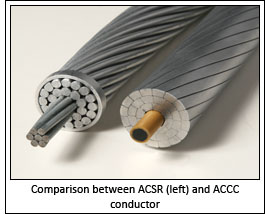 — Dave Bryant, Director - Technology,
CTC Global Corporation
— Dave Bryant, Director - Technology,
CTC Global Corporation
US-based
CTC Global Corporation has developed and owns the
rights to the highly efficient ACCC (aluminium conductor composite
core) technology. Recently, CTC completed its first installation in
India in association with its Indian partner Sterlite Technologies Ltd.
In this exclusive exchange,
Dave Bryant discusses the ACCC
technology and how it fits perfectly into India's growing need for
high-efficiency power transmission lines. Bryant asserts that ACCC
technology can contribute to bring about much needed efficiency to
the Indian grid. An interview by
Venugopal Pillai.
Tell us more on Torrent's 132kV power transmission line in
Gujarat - CTC's first ACCC conductor deployment in India.
Torrent Power Ltd is one of the leading private electrical
utilities in the Indian power sector. Torrent wanted to double
the capacity of an existing 132kV transmission line between
two substations in Ahmedabad, one of the major cities in
Gujarat in the western part of India, without the need to
reinforce or modify existing lattice structures. Torrent's
selection of ACCC® over other conductor options was based on
its low energy loss feature which, according to Torrent, directly
contributes to their bottom line. Torrent has taken leadership
role in India's adoption of high capacity, high efficiency
conductors, and CTC Global believes that the important step
they have taken will add confidence in ACCC conductor
throughout India.
With the collaboration agreement with Sterlite in place and
your first project commissioned, how do you see the future for
ACCC in India?
Like many other countries worldwide, India's demand for
affordable and reliable power is important to its economic
prosperity. Earlier this year, India experienced the worst
blackout ever recorded, impacting an estimated 670 million
people. The ACCC conductor's ability to double the current
carrying capacity of an existing transmission corridor without
requiring structural modifications makes it a very costeffective
way to upgrade and stabilize the Indian power grid.
Another key advantage to the use of ACCC conductor
compared to any other conductor of the same diameter and
weight is that the ACCC conductor reduces line losses under
any load condition by 30 to 40 per cent. This substantial
reduction in line losses allows the utility to deliver more power
to its customers with less generation investment/resource.
Similarly, fuel consumption can be reduced, which in many
cases can also reduce greenhouse gas and other emissions.
We understand that government-owned power transmission
utilities can be a big business opportunity given major "reconductoring"
works always on hand. How do you view this
public sector market in India? CTC Global believes that power companies, both public and
private, have a strong appreciation for modern, cost-effective
technologies that can improve the efficiency, capacity and
reliability of their transmission assets. While it takes time for
such a large and conservative industry to fully appreciate the
attributes of any new technology, the ACCC conductor has been
extensively tested, widely deployed and proven at over 220
project sites worldwide.
For example, American Electric Power (AEP), having
completed eight ACCC installations in the last seven years,
recently signed an agreement with CTC Global to purchase
about 2,700 kilometers of ACCC conductor for a single project
in Texas (a 345kV reconductoring project that will remain
energized during the installation). CTC Global believes that as
Indian utilities gain more experience with new technologies
such as ACCC, they, like AEP, will deploy them on larger scale
projects.
CTC Global also believes that the recent blackout in India will
prompt Indian utilities to take necessary steps toward
upgrading their grid, which in many ways can be accomplished
by using ACCC. As such, CTC Global sees a paradigm shift in the
approach of the public sector market in India toward the
adoption of technologies including ACCC. A few states have
adopted it already, and a few others are in the final stages of
adoption.
Coming to the technology, can you summarize and quantify the
technical advantages of ACCC over conventional conductors
like ACSR, HTLS, etc?
ACSR is a conductor that consists of a number of steel core
strands surrounded by conductive aluminum strands. The steel
strands are used to improve the conductor's overall strength.
There are also a variety of other conventional conductor types
that rely on higher strength aluminum alloys to increase overall
conductor strength, but the conductivity and efficiency of the
alloy typically decreases as their strengths increase.
High-Temperature Low-Sag (HTLS) conductors such as
ACSS, ACCR, INVAR, GAP and others offer increased operating
temperatures and reduced thermal sag. Unfortunately, line
losses increase exponentially at higher operating
temperatures, so, while some initial capacity increases and
cost savings may be realized, in the long term, line losses can
prove to be very costly, especially when you consider the cost
of the generation asset required to support those losses.
Internationally, it is well recognized that it is cheaper to save a
"megawatt" than it is to produce a megawatt.
 At the "core" of it, is ACCC a case of carbon scoring over steel?
At the "core" of it, is ACCC a case of carbon scoring over steel?
Hybrid carbon fiber composites offer several advantages over
steel, which are well recognized in the aerospace, automotive,
marine and many other industries where efficiency,
performance and reliability are extremely important. Carbon
fiber composites offer increased strength, lighter weight,
corrosion resistance, a very low coefficient of thermal
expansion, and, most importantly, excellent resistance to cyclic
load fatigue. All of these attributes and others help elevate the
performance of the ACCC conductor above any other conductor
type of the same diameter and weight.
The ACCC conductor's greater strength, dimensional
stability and excellent self-damping characteristics allow it to
accommodate greater spans between fewer and/or shorter
structures which can serve to reduce up-front capital costs and
construction challenges on new lines. The ACCC conductor's
added aluminum content compared to other conductors of the
same diameter and weight helps increase capacity and reduce
line losses.
We hear of a new-age conductor AAAC being used extensively
in Europe. How does ACCC compare?
All Aluminum Alloy Conductors are not new, but because they
don't use a steel core, they, like ACCC, are less prone to
corrosion. Generally speaking, AAAC coefficients of thermal
expansion, operating temperature ranges and strength
limitations restrict the applications for which they can be
considered. That said, like many of the modern conductors,
AAAC can outperform ACSR conductor in many cases. To truly
evaluate the benefits between any two conductors for a specific project, CTC Global has developed the CCPTM software
program (offered at no charge) that can allow a system planner
or a line engineer to compare the electrical, mechanical and
financial impact of almost any conductor.
Tell us how has been the growth of ACCC globally since its
launch in 2005. Which countries are currently your biggest
markets?
According to Electric Power Research Institute (US) data, the
ACCC conductor has been more widely deployed compared to
any other newly developed conductor on the market today in
the same time period. To date, CTC Global has delivered more
than 14,000 km of conductor to over 220 project sites in 24
countries.
How do you view the market in India vis-à-vis other emerging
economies, mainly China? Is China home to any of CTC's ten
manufacturing partners?
China and India both represent substantial markets for ACCC
conductor due to the growing demand for affordable power.
CTC Global currently has two licensed stranding partners in
China.
India's power transmission ambitions currently involve highvoltage
technology like HVDC, UHVAC, etc. How does ACCC fit
into this scheme?
The ACCC conductor was initially developed to increase the
capacity of thermally constrained transmission lines typically
operating at or under 400kV due to the conductor's superior
resistance to thermal sag. However, its high strength, light
weight, improved efficiency and resistance to cyclic load
fatigue also make it ideally suited for higher voltage
applications where upfront capital costs, life cycle costs and
reliability are paramount concerns.
Kindly summarize CTC's way forward in India in the medium term.
CTC Global is making great strides in India to learn the needs of
the utilities and better understand how the ACCC conductor
technology can help them improve the efficiency, capacity and
reliability of their grid, which is currently plagued with a high
amount of power loss. While a number of other alternatives are
available, the utilities that are learning about ACCC and gaining
confidence in its measured performance are realizing that its
economics are hard to beat. CTC Global will continue to share
its expertise and develop strong relationships with the Indian
utilities and others worldwide. CTC Global also plans to serve
the Indian utilities by providing them with the most economical
solution to upgrade their grid and reduce overload. To support
this objective, CTC Global has also published an Engineering
Manual and developed a software program (CCP™) that it
offers to utility personnel and transmission engineers at no
charge. In addition to engineering support, CTC Global
provides installation training and other services.